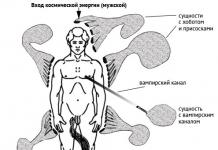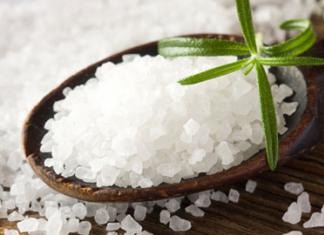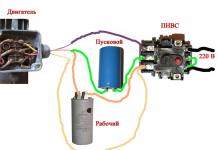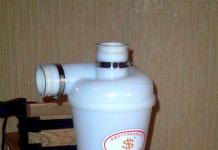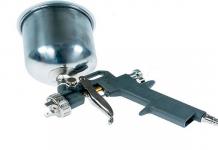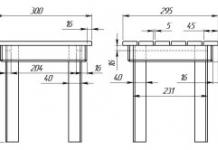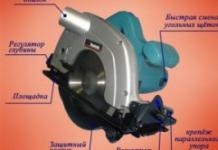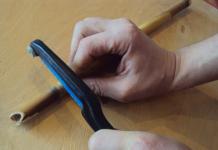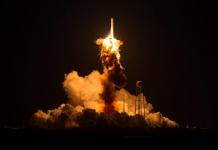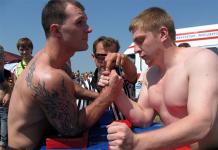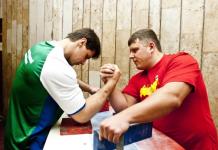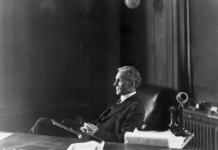
The history of space exploration also has a tragic side. In total, about 350 people died during unsuccessful space flights and preparations for them. In addition to astronauts, this number also includes local residents and spaceport personnel who died as a result of falling debris and explosions. In this article, we will look at five disasters where the pilots of spacecraft directly became victims. The saddest thing is that most accidents could have been avoided, but fate decreed otherwise.
Apollo 1
Death toll: 3
Official reason: spark due to short circuit in poorly insulated wiring

The world's first fatal space disaster occurred on January 27, 1967, with American astronauts during training in the command module of the Apollo 1 mission vehicle.
In 1966, the moon race between the two superpowers was in full swing. Thanks to spy satellites, the United States knew about the construction of spacecraft in the USSR that could possibly take Soviet cosmonauts to the moon. The development of the Apollo spacecraft, therefore, was carried out in great haste. Because of this, of course, the quality of technology also suffered. The launch of two unmanned versions, AS-201 and AS-202, was successfully launched in 1966, and the first manned flight to the Moon was scheduled for February 1967. For crew training, the command module of the Apollo spacecraft was delivered to Cape Canaverall. The problems started from the very beginning. The module was seriously flawed, and dozens of engineering adjustments were made right on the spot.
On January 27, the planned simulation training in the module was supposed to take place to test the performance of all on-board instruments of the ship. Instead of air, oxygen and nitrogen were filled into the cabin in a ratio of 60% to 40%. The training started at 1pm. It took place with constant malfunctions - there were problems with communication, and the astronauts constantly smelled of burning, as it turned out as a result - due to a short circuit in the wiring. At 18:31, one of the cosmonauts shouted over the intercom: “Fire in the cabin! I'm on fire! Fifteen seconds later, unable to withstand the pressure, the module burst. The cosmodrome employees who came running could not help - astronauts Gus Grissom, Ed White and Roger Chaffee died on the spot from numerous burns.

Soyuz-1
Death toll: 1
Official reason: failure of the brake parachute system / flaws in the production of the spacecraft

On April 23, 1967, a grand event was scheduled - the first ever launch of a Soviet spacecraft of the Soyuz series. According to the plan, Soyuz 1 was the first to launch, piloted by Vladimir Komarov. Then it was planned to launch the Soyuz-2 spacecraft with Bykovsky, Eliseev and Khrunov on board. In open space, the ships were to dock, and Eliseev and Khrunov were to transfer to Soyuz-1. In words, everything sounded big, but from the very beginning something went wrong.
Immediately after the launch of Soyuz-1, one solar battery did not open, the ion orientation system was unstable, and the solar-stellar orientation sensor failed. The mission had to be terminated urgently. The Soyuz-2 flight was canceled and Vladimir Komarov was ordered to return to Earth. Here, too, serious problems arose. Due to the failure of the systems and the displacement of the center of mass, it was impossible to orient the ship for braking. Due to his professionalism, Komarov almost manually oriented the ship and successfully entered the atmosphere.
After the ship left orbit, a braking impulse was applied and an emergency detachment of the compartments was made. However, at the last stage of the landing of the descent vehicle, the main and reserve drogue parachutes did not open. At a speed of about 150 km / h, the descent vehicle crashed into the Earth's surface in the Adamovsky district of the Orenburg region and caught fire. The apparatus was completely destroyed in the collision. Vladimir Komarov died. The reason for the failure of the brake parachute system could not be established.

Soyuz-11
Death toll: 3
Official reason: premature opening of the ventilation valve and further depressurization of the cabin

1971 The USSR lost the lunar race, but in response created orbital stations, where in the future it was possible to stay for months and do research. The world's first expedition to the orbital station was successfully completed. The crew consisting of Georgy Dobrovolsky, Vladislav Volkov and Viktor Patsaev stayed at the station for 23 days, however, after a serious fire at the OS, the cosmonauts were ordered to return to Earth.
At an altitude of 150 km. separation has occurred. At the same time, the ventilation valve opened involuntarily, which was supposed to open at an altitude of 2 km. The cabin began to fill with fog, which condensed due to pressure drop. After 30 seconds, the astronauts lost consciousness. After another 2 minutes, the pressure dropped to 50 mm. rt. Art. Since the astronauts did not have spacesuits, they died from suffocation.

Despite the fact that the crew did not respond to MCC questions, re-entry, braking and landing were successful. After this tragic incident, Soyuz pilots began to be supplied with space suits without fail.
Shuttle Challenger
Death toll: 7
Official reason: gas leak in the elements of the solid fuel booster

The mid-1980s were a real triumph for the American Space Shuttle program. Successful missions took place one after another at unusually short intervals, sometimes no more than 17 days. The Challenger mission STS-51-L was significant for two reasons. Firstly, she broke the previous record, as the interval between missions was only 16 days. Secondly, the Challenger crew included a school teacher whose task was to conduct a lesson from orbit. This program was supposed to generate interest in space flight, which has subsided somewhat in recent years.
On January 28, 1986, the Kennedy Space Center was packed with thousands of spectators and journalists. About 20% of the country's population watched the live broadcast. The shuttle soared into the air to the cries of the admiring audience. Everything went well in the beginning, but then puffs of black smoke were visible coming out of the right solid rocket booster, and then a torch of fire appeared from it.
A few seconds later, the flame became significantly larger due to the combustion of the leaked liquid hydrogen. Approximately 70 seconds later, the destruction of the external fuel tank began, followed by a sharp explosion and detachment of the orbiter's cabin. During the fall of the cabin, the astronauts remained alive and conscious, they even made attempts to restore the power supply. But nothing helped. As a result of the impact of the orbiter cabin on the water, at a speed of 330 km / h, all crew members died on the spot.

After the shuttle exploded, numerous cameras continued to film what was happening. The faces of shocked people got into the lenses, among which were the relatives of all seven dead astronauts. Thus was filmed one of the most tragic reports in the history of television. After the disaster, a ban was imposed on the operation of shuttles for a period of 32 months. The system of solid-fuel boosters was also finalized, and a parachute rescue system was installed on all shuttles.
Shuttle Columbia
Death toll: 7
Official reason: damage to the heat-insulating layer on the wing of the device

On February 1, the shuttle Columbia successfully returned to Earth after a successful space mission. Initially, reentry into the atmosphere proceeded normally, but later a thermal sensor on the left wing transmitted an anomalous value to the MCC. A piece of thermal insulation broke off from the outer skin, as a result of which the thermal protection system failed. After that, four sensors of the ship's hydraulic system went off scale, and literally 5 minutes later the connection with the shuttle was cut off. While the MCC personnel were trying to contact Columbia and find out what happened to the sensors, one of the employees saw live the shuttle already falling to pieces. The entire crew of 7 people died.
This tragedy dealt a serious blow to the prestige of American space exploration. Shuttle flights were once again banned for 29 months. In the future, they performed only critical tasks for the repair and maintenance of the ISS. In fact, this was the end of the existence of the Space Shuttle program. The Americans were forced to ask Russia to transport cosmonauts to the ISS on Russian Soyuz spacecraft.
On January 28, 1986, at 74 seconds after launch, the American spacecraft Challenger exploded. 7 astronauts died.
The Space Shuttle program has become the most difficult for NASA. Already the first start of "Columbia" was postponed three times, achieving the flawless operation of the systems. The launch of the first space shuttle in manned mode took place on April 12, 1981. On board Columbia, two astronauts worked for two days and six hours.
In the first flight of the Challenger, in the summer of 1983, astronaut Sally Ride took part as a flight engineer. She specialized in working with a mechanical manipulator - a giant arm, launching and capturing artificial satellites from orbit. Together with flight engineer John Fabian, using a 15-meter electronic-mechanical manipulator equipped with two television cameras, they launched a communications satellite into orbit, and then returned it to the cargo hold.
The Challenger reusable vehicle is a combination of a manned orbital stage (space plane), two identical solid rocket boosters (STBs) and a fuel tank with liquid fuel. Rocket boosters are designed for acceleration in the initial part of the trajectory, their operation time is a little more than two minutes. At an altitude of about 40-50 km, they separate and then splash down on parachutes in the waters of the Atlantic Ocean. An outboard fuel tank in the form of a giant cigar supplies liquid oxygen and hydrogen to the main propulsion system located in the tail section of the orbital stage. Empty, it separates and burns in the dense layers of the atmosphere. The most complex part of the complex is the orbital stage, outwardly resembling an aircraft with a delta wing. Each ship in the series is capable of flying 100 to 500 times. The moment of landing was considered the most dangerous part of the flight. The speed of the ship during re-entry into the atmosphere is several times greater than the speed of the fighter. Landing must be done the first time.
The Challenger was striking in its size: its mass at the start was 2000 tons, of which 1700 tons were fuel.
The launch of shuttle spacecraft, as well as the implementation of the entire space program of the United States, is provided by NASA. The decision to do so was made in the 1950s. But almost the lion's share of space shuttle flights was funded by the US Air Force. Initially, they saw shuttles as the ideal vehicle for launching military satellites into orbit. But later, due to frequent malfunctions in the systems of shuttle ships, the Air Force command again inclined to launch some of the most expensive satellites with the help of rockets and thus keep in reserve a spare means of launching various objects into orbit.
The US space program for 1985 was extremely ambitious, and in 1986 it became even more strenuous. NASA never gives permission for a launch unless it is absolutely certain that everything is carefully prepared for launch. At the same time, the Aeronautics Administration was required to adhere to the officially announced flight schedule at all costs. But it was not possible to withstand it, there was a lag, and for this the leadership of NASA was sharply criticized both from the pages of the press and in Congress.
Under mounting pressure from above, NASA leaders were forced to demand from all departments to speed up work as soon as possible and at the same time ensure maximum flight safety. But NASA is a very conservative organization, they do not tolerate even the slightest deviation from instructions. Until 1986, there were 55 launches of American manned spacecraft - and not a single catastrophe in the air. In 1967, the ship burst into flames on the launch pad, killing three astronauts. Twenty-four shuttle flights were successful. Everyone was waiting for the twenty-fifth.
What was the purpose of the next Challenger flight? It was planned to launch and then, after a meeting with Halley's comet, again take on board an artificial satellite. It was also planned to launch a communications satellite into orbit. Particular attention was riveted to the teacher Christa McAuliffe. Two years before the start in the United States, at the initiative of President Ronald Reagan, a competition was announced, which received eleven thousand applications. The "Teacher in Space" program dealt with mechanics, physics, chemistry, and space technology. It was supposed to consider under weightless conditions the action of Newton's laws, simple mechanisms, the passage of hydroponics, foaming, and chromatography processes. Christa McAuliffe was preparing to teach two lessons that the non-profit PBS broadcaster was going to broadcast to hundreds of schools on the fourth day of the flight.
The Challenger crew consisted of seven people: Francis Dick Scobie, 46, commander of the ship, an Air Force major from Auburn, Washington; Michael Smith, 40, co-pilot, served in the United States Navy, based in Morehead City, NC; Ronald McNair, 35, PhD, Lake City, SC; Allison Onizuka, 39, Air Force Major, Kilakekua, Hawaii; Christa McAuliffe, 37, teacher, Concord, New Hampshire; Gregory Jarvis, 41, Satellite Engineer, Detroit, Michigan; Judith Resnick, 36, PhD, Akron, Ohio.
The Space Shuttle Challenger mission, code number STS-51-L, has been repeatedly delayed. The first time it happened on December 23, 1985. The launch was postponed to January 22, but complications with a similar type of spacecraft Columbia forced the flight to be delayed by another day. On the eve of this date, a new one is set - January 25. Then, due to adverse weather conditions, the launch is scheduled for January 26. However, experts again assess the weather as unsuitable for the start - there was an unexpectedly sharp cooling. January 27 is the first day when the launch is recognized as really possible and pre-launch tests of the spacecraft systems are carried out. After midnight, refueling of the external tank began.
At 7:56 a.m., the astronauts take their seats aboard the Challenger. But at 09:10, the pre-launch countdown suddenly interrupted: one of the handles of the side hatch jammed, and it was not possible to close it tightly. While the malfunction was being fixed, in the area of the runway intended in case of an emergency landing, the wind increased so much that at 12.35 it was decided to postpone the launch to the next day.
The weather forecast predicted cloudless skies and below-zero air temperatures by nightfall. At 2:30 a.m., a special ice-clearing team went to check the condition of the surface of the spacecraft on the launch pad. At 0300, the team returned to base and warned that it was necessary to check the degree of icing of the Challenger again three hours before launch.
At 7:32 a.m. due to low cloud cover and expected rain, the time for boarding the shuttle was delayed by an hour. This "extra" hour allowed the astronauts to have breakfast slowly and with all conveniences. At 8:03 a.m., the astronauts boarded a minibus. At 8:36 a.m., they took up seats aboard the Challenger. The launch was scheduled for 9.38, however, having yielded to the demand of the de-icing team, the flight directors were forced to delay it by another two hours.
During the forced delay, Judith Resnick, the second female astronaut in US history, gave a short interview. Despite the fact that the crew consisted of seven astronauts, Judith emphasized that there were six of them, which means that she bears a sixth of the responsibility for the success of the entire space expedition. Professional Reznick defiantly refused to recognize Christa McAuliffe, a teacher who was simply lucky, as her equal. Still, Judith had been preparing for her first flight for six years.
On January 28, 1986, at 11:38:00:010, the Challenger finally took off. Among those watching the launch were students from Christa McAuliffe's class. The rest of the students at the school in Concord, where she taught, watched the start on TV. And at Cape Canaveral, among other guests, are her father, mother, husband, lawyer Steve McAuliffe, and their two children, nine-year-old Scott and six-year-old Caroline.
The flight seemed to be proceeding normally in all respects. At the 57th second, the control center reported: the engines are working at full load, all systems are functioning satisfactorily.
The last words that sounded from the Challenger and recorded on magnetic tape belonged to the commander of the ship, Francis Dick Scobie: "Roger, go at throttle up", which means something like this: "It's all right, we're going at full speed."
No emergency signals were received from the flight deck; the first signs of the catastrophe were noted not by instruments, but by television cameras, although the control and measuring equipment installed on board the spacecraft was properly, until the very last moment, fed electronic impulses to the Earth. 73.618 seconds after launch, the radar screen clearly showed the trajectories of numerous debris falling into the sea, and the NASA officer on duty stated: "The ship exploded."
What the people who watched the launch did not see, and did not fix the devices, became obvious when they developed the films shot by photo machines and analyzed the video recordings with the help of computers in super slow motion mode.
After 0.678 seconds after the launch, a cloud of gray smoke appeared in the area of the lower junction of the sections of the right solid propellant booster (TTU). The accelerator consists of eleven basic sections; smoke appeared where the Challenger engine was adjacent almost to its body.
Between 0.836 and 2.5 seconds, eight wisps of smoke are clearly visible, taking on an increasingly darker hue.
2.733 seconds after liftoff, the jets disappear: by this point, the spacecraft is moving at such a speed that it breaks away from its smoke plume.
Flight time 3.375 seconds. Behind the Challenger, gray wisps of smoke are still visible at some distance; according to experts, its black-gray color and density may indicate that the insulating material is burning at the junction of the accelerator sections, where two so-called ring seals are located.
58,788. In the place where the smoke made its way from the accelerator, a flame appears.
59.262. From that moment on, the fire is seen quite distinctly. At the same time, computers for the first time note the different thrust of the right and left accelerators. The thrust force of the right one is less: burning gas flows out of it.
64.60. The color of the flames changes as the hydrogen contained in the huge external fuel tank to which both the two boosters and the Challenger itself are attached begins to leak. Inside the tank is divided in two by a thick partition; on one side is liquefied hydrogen, on the other - liquefied oxygen; Together they form a combustible mixture that feeds the Challenger's engine.
72.20. The lower mount that connects the right solid fuel booster to the outboard tank breaks. The accelerator begins to rotate around the top mount. At the same time, liquid hydrogen continues to leak through the hole in the tank body; that part of it that still remains in the tank passes into a gaseous state and with increasing force presses on the inner partition. Turning around the upper mount, the right rocket booster strikes the fuel tank wall with its tip, pierces it and now releases oxygen, as evidenced by a white cloud. This happens 73.137 seconds after launch. At an altitude of 13800 m, the Challenger turns into a flaming torch, rushing about twice as fast as sound. In five tenths of a second it falls apart.
The explosion occurred when the Challenger passed the zone of maximum aerodynamic pressure. At this time, the ship is experiencing very large overloads. The commander of the fifth expedition under the Space Shuttle program said that at that moment it seemed to him that the ship was about to fall apart. Therefore, when passing through this zone, the engines should never operate at full power.
The accident occurred at the moment when the commander of the ship, Dick Scobie, turned on the maximum speed. Once, in a conversation with a reporter, he said: "This ship is bound to explode someday." Dick Scobie, test pilot, later served in Vietnam, where he took part in many operations and received several awards. The structure of the ship is extremely complex, he said, and at the same time it is literally filled with explosive substances; take at least one solid-propellant rocket capable of giving the ship a speed of 17 thousand miles per hour; and there is also a hanging tank with several hundred thousand pounds of easily exploding liquefied gases. It is enough to fail some insignificant system for this whole colossus to shatter into smithereens. It happens in aviation that out of many equally reliable aircraft, one suddenly crashes and crashes.
At the same time, Dick Scobie emphasized that, even if this happens, the catastrophe should not become an obstacle to the further implementation of the space program. And flights, of course, will continue, although a certain time will surely pass before they resume.
Leo Krupp, a former Rockwell test pilot and space shuttle expert, when asked if the astronauts could have escaped, replied: “You know, all these events developed so quickly that they probably didn’t notice anything. have time. In general, if, for example, the ship deviates from a given trajectory, then the head of the flight control center group for trajectory control immediately sends a signal to the ship about this and the corresponding indicator lights up on the instrument panel in the cockpit. The ship's commander has a few seconds to turn on the system for emergency uncoupling of the "shuttle" from the external fuel tank and booster rockets. To do this, just move one lever to the lower position and press the button. If the commander had done this today, the Challenger would have remained intact. But before the commander does this, in order to avoid any misunderstandings, he must wait for the confirmation of the alarm by the head of the flight safety team. However, as far as I know, in this case, the critical situation arose so quickly that the head of the security team simply did not have time to realize anything and make a decision ... "
President Ronald Reagan and his senior staff were in the Oval Office preparing for a meeting with television correspondents and editors when Vice President Bush and National Security Adviser Poindexter entered. They told the President what had happened. The meeting was immediately interrupted, and everyone went to the president's office, where there is a TV. Reagan, alarmed, upset, was looking forward to new information. A few hours later, he tried to console the saddened country with a heartfelt speech. Addressing America's schoolchildren, the president said, “I understand it's very hard to realize that such bitter things sometimes happen. But it's all part of a process of exploration and expanding the horizons of humanity."
The Americans were shocked. Over the past quarter century, US scientists and astronauts have made 55 space flights, and their successful return to Earth has been taken for granted. It began to seem to many that in America, almost every young man, having trained for several months, could go into space.
The tragedy of the Challenger was especially hard to bear in Concord. After all, there, in the school auditorium, McAuliffe's colleagues and students who knew her well gathered in front of the TV. Oh, how they expected her performance, how they hoped that she would glorify their town throughout America! When the tragic news of the loss of the Challenger spread, all thirty thousand inhabitants of Concord plunged into mourning.
Soviet radio broadcast condolences to the American people. Moscow has announced that two craters on Venus will be named after the two women who died on the spacecraft - McAuliffe and Reznik.
In the Vatican, Pope John Paul II asked thousands of people gathered to pray for the dead astronauts - in his soul, the tragedy caused a feeling of deep sadness.
Mourning was declared in the USA. In New York, the lights went out in the tallest skyscrapers. On the coast of Florida, twenty-two thousand people held burning torches. In memory of the dead astronauts in the capital of the 1984 Olympic Games, Los Angeles, the Olympic flame was again lit.
And at Cape Canaveral, US Coast Guard and NASA teams searched for the wreckage of the Challenger. They did not start work until an hour after the explosion, because the fragments kept falling. The search area covered about 6 thousand square meters. miles of the Atlantic Ocean.
Despite the enormous force of the explosion, the search parties found large fragments of the Challenger scattered across the ocean floor.
Perhaps the most dramatic thing was that the bow of the Challenger with the crew turned out to be intact - it just fell down into the sea, and collapsed only when it hit the surface of the water. The wreckage of the cabin was found at the bottom of the sea only a few months later, at a depth of 27 m. The remains of the crew were removed from the water and identified within a few weeks.
Four days later, on Friday, America said goodbye to the brave seven. In the vicinity of Houston, relatives of the victims, congressmen and about six thousand NASA employees gathered. President Reagan delivered a speech.
On February 6, a commission to investigate the crash was sworn in, chaired by former Secretary of State William Rogers. Among the thirteen members of the commission are General Chuck Yeager, the first pilot to fly at supersonic speed; Neil Armstrong, the first person to walk on the moon; Sally Ride, the first female astronaut in the United States.
A specially created commission began to interrogate in closed sessions the senior officials of NASA and the engineers of Morton Thiokol, a supplier of solid-propellant launch vehicles, which were supposed to have led to the tragedy.
The materials of the commission for the investigation of the catastrophe describe the principle of connecting sections of a solid-propellant booster rocket. The edge of the edge of one of the sections forms a clamp, into which the pin of the other section fits tightly. A similar principle is applied when gluing a model, where the protruding part of one part fits into the groove of another. The peculiarity of this connection is that the groove and the pin are located in a circle, and the function of the glue is performed by a special insulating sealant. To ensure greater safety, two O-rings made of dense rubber are installed at the junction of the sections; in the event of gaps, the seals move and cover them. Among the fragments of the accelerator rocket lifted from the bottom of the Atlantic Ocean, there were two nodes damaged to a critical degree. Between clamp No. 131 and a piece of pin No. 712 fitted to it, there is a gaping hole, burned equally both from the outside and from the inside. This fragment is part of the right accelerator, charred to the lower intersection joint. The insulation failed in the most dangerous place - where the accelerator is attached to the fuel tank. Having lost its lower attachment, the accelerator turned around the top one and, like a spear, stuck into the fuel tank.
It has been experimentally established: when starting a solid fuel accelerator, a gap is formed between the clamp and the pin, depending on the traction force of the accelerator - 0.17-0.29 inches (0.42-0.73 cm). This gap must be closed with an elastic O-ring. The latter, however, functions differently at normal and at low temperatures. Experiments conducted by order of the Rogers Commission showed that at a temperature of plus 25 degrees Celsius, the seals take on their original shape many times faster than at a temperature of zero.
Twenty-one times shuttle spacecraft took off at air temperatures above 17 degrees Celsius, yet on four occasions one of the O-rings burned out. Three times the launch was carried out at a temperature below 17 degrees, and two times one of the seals was completely destroyed, and in one case the second safety seal turned out to be seriously damaged. But in such cold weather as it was before the flight of STS-51-L, the shuttle spacecraft had never yet taken off. At the time of the launch of the Challenger, the air temperature was only plus 2 degrees Celsius; on the shady side of the right solid propellant booster (where the insulation later failed), the external temperature of the steel sheathing did not exceed minus 3 degrees.
The decision to launch the Challenger was wrong - this was the conclusion of the commission to investigate the causes of the disaster. The documents say: those who made this decision are unfamiliar with the peculiarities of the functioning of the ring seals; they do not know that the instruction of the manufacturer of the seals does not recommend starting at an air temperature below plus 11 degrees; they also did not know that representatives of the Rockwell International Corporation (which developed the shuttle spacecraft system) paid attention in advance to the possible dangerous consequences of icing of certain Challenger nodes before launch. Those who knew all this did not decide anything, or rather, considered that these questions were not significant enough, were too private in nature to report on them to superiors.
The first document that rejected the principle of connecting sections of solid rocket boosters was dated October 21, 1977. Since then, twenty-two memos have been written about the shortcomings inherent in O-rings and sealants. The last date is October 9, 1985. The notes circulated mainly through the shops and departments of the manufacturer, some even got to the NASA space center in Alabama, but not a single one reached the top of the management pyramid.
January 27, 1986, the day before the launch of the Challenger, one of the engineers of the Thiokol concern, which produces solid-propellant rockets, namely a specialist in insulating materials, draws the attention of his superiors to the fact that, according to meteorologists, the air temperature in Florida in 11 hours will drop below zero - the launch of a spacecraft in such conditions is extremely dangerous. The leaders of the concern contact the responsible figures of NASA and hold a long meeting with them by phone. Engineers protest against the launch scheduled for the morning and present their arguments, but NASA declares the discussion irrelevant, since there is no actual evidence that O-rings will fail in the cold. As a result, one of the representatives of the J. Marshall Space Center in Alabama exclaims indignantly: “What are we to do - wait until the temperature rises to eleven degrees? And if this happens not earlier than April ?! The vice president of the Thiokol concern asks for five minutes of delay to consult with employees. However, he calls again only two hours later. His engineers now believe that if the first O-ring fails, the second O-ring will surely work and provide sufficient safety. The concern gives the go-ahead for the launch, and a facsimile copy of the relevant document is immediately transmitted by phototelegraph.
What happened in the Thiokol concern during these two hours?
At a quarter to nine in the evening on January 27, the specialists of the concern - the manufacturer of solid rockets, are still strongly protesting against the risky launch of the Challenger. However, by eleven, they assure in writing that they do not see anything dangerous. Interrupting the telephone meeting, the concern's vice president, Gerald Mason, first listens to the opinions of his subordinates, and then invites them to leave the office, stating that in this case, not so much an engineering solution as a business solution is required. He asks chief engineer Robert Lund to stay and severely punishes him: "Take off your engineering hat and put on a businessman's top hat for a while."
The government commission studied more than six thousand documents published in the form of four-volume materials of the case. The summary of Rogers' report is as follows: “The Commission found that the administration of the Thiokol concern changed its position and, at the insistence of the Marshall Space Center in Alabama, agreed to the implementation of the STS-51-L flight. This was contrary to the opinion of the concern's engineers and was done solely to please a large customer.
Holding a public hearing before the Senate Subcommittee on Science, Technology and Space, Senator Ernest Holdings said of the catastrophe: "Today it looks like it could have been avoided." Later, he would press charges against NASA, which "apparently made a political decision and rushed to carry out the launch despite strong objections."
The forced timeout in the launch of the shuttles lasted two and a half years, which experts estimate as the most difficult in the history of American astronautics. In general, the entire Space Shuttle program was revised. While the investigation was underway, the ship's systems were being finalized, numerous checks were made on the operation of units and systems. One and a half billion dollars was spent on the modification of the shuttle. According to engineers, the new design required a fourfold increase in the amount of work compared to the base model. NASA tried to present Discovery to the public as if it were a completely new ship. Engineers made 120 changes to the design of the orbiter and 100 to its most advanced computer hardware. The main attention was paid to the most dangerous joints. At the joints, the thermal insulation layer was increased, an additional ring seal and even heaters were installed to avoid possible overcooling of the seal.
On September 29, 1988, after the successful Discovery flight, America breathed a sigh of relief: the country returned to space flights with astronauts on board. The ship's crew of five was for the first time dressed in orange rescue suits and equipped with individual parachutes and watercraft - in case of an accident during landing. However, during the launch of the "shuttle" into orbit, it is still impossible to save the crew. In order to create such a rescue system, it would be necessary to significantly change the design of the ship, which is economically unprofitable.
In the mid-1980s, the American space program was at the height of its power. After winning the “moon race”, the United States has established itself in the opinion of its unconditional leadership in space.
Another proof of this was the space exploration program with the help of the Space Shuttle reusable vehicles. Space shuttles, whose operation began in 1981, made it possible to launch a large amount of payload into orbit, return failed vehicles from orbit, and also fly with a crew of up to 7 people. No other country in the world had such technologies at that time.
Unlike the USSR, the US manned program did not know of accidents with human casualties during flights. More than 50 expeditions in a row ended successfully. Both the country's leadership and ordinary people have the opinion that the reliability of American space technology is an absolute guarantee of safety.
The idea arose that under the new conditions, anyone with normal health and a not too difficult and lengthy training course could fly into space.
"Teacher in Space"
At US President Ronald Reagan there was an idea to send an ordinary school teacher into space. The teacher had to conduct several lessons from orbit to increase the children's interest in mathematics, physics, geography, as well as science and space exploration.
In the United States, the "Teacher in Space" competition was announced, which received 11,000 applications. There were 118 candidates in the second round, two from each state and subject territories.
The final results of the competition were announced solemnly in the White House. US Vice President George Bush July 19, 1985 announced: the winner was 37-year-old Sharon Christa McAuliffe, the second place was taken by the 34-year-old Barbara Morgan. Christa became the main candidate for the flight, Barbara became her understudy.
Christa McAuliffe, a mother of two who taught high school history, English and biology, wept with happiness during the announcement of the competition results. Her dream came true.
To those close to her, whose pride in Krista alternated with anxiety, she explained: “This is NASA, even if something goes wrong, they can fix everything at the last moment.”
After completing a three-month training program, Christa McAuliffe was included in the crew of the Challenger spacecraft, which was supposed to go into orbit in January 1986.
Anniversary start
The Challenger flight was supposed to be the 25th anniversary launch under the Space Shuttle program. Specialists sought to increase the number of expeditions into orbit - after all, fabulous money for the implementation of the project was allocated with the expectation that over time the "shuttles" would pay off and begin to make a profit. In order to achieve this, it was planned to reach the figure of 24 flights per year by 1990. That is why the program managers were extremely annoyed by the words of experts about the serious shortcomings in the design of the ships. Minor malfunctions had to be eliminated almost before each start, and there were fears that sooner or later everything could end in big trouble.
The crew of the STS-51L expedition, in addition to Christa McAuliffe, included the commander Francis Scobee, first pilot Michael Smith as well as astronauts Allison Onizuka, Judith Resnick, Ronald McNair and Gregory Jarvis.

The crew of the Challenger. Photo: www.globallookpress.com
In addition to school lessons from orbit, the mission program included launching satellites into orbit and observing Halley's comet.
Initially, the launch from the Cape Canaveral spaceport was scheduled for January 22, but then was postponed several times until the new date became January 28.
That morning, there was also suspicion that the flight would have to be rescheduled - it got very cold in Florida, the temperature dropped below zero, and icing appeared on the launch site. The management decided not to cancel the start, but simply postpone it for a couple of hours. At a new inspection, it turned out that the ice began to melt, and the go-ahead for the start was received.
"Critical situation"
The final launch was scheduled for 11:38 local time on January 28, 1986. Relatives and friends of the astronauts, colleagues and students of Christa McAuliffe gathered at the spaceport, waiting for the moment when the first teacher will go on a space journey.
At 11:38 a.m., the Challenger lifted off from Cape Canaveral. In the stands, where the audience was, jubilation began. A close-up television camera showed the faces of Krista McAuliffe's parents as they saw their daughter off for the flight, smiling, rejoicing that their girl's dream had become a reality.
Everything that happens at the cosmodrome was commented on by the announcer.
52 seconds after the launch, the Challenger began its maximum acceleration. The ship's commander, Francis Scobie, confirmed the start of acceleration. These were the last words spoken from the shuttle.
At the 73rd second of the flight, viewers watching the launch saw the Challenger disappear in a white cloud of explosion.
The audience at first did not understand what had happened. Someone was frightened, someone applauded admiringly, believing that everything was going according to the flight program.
It seemed that the announcer also thought that everything was in order. “1 minute 15 seconds. The speed of the ship is 2900 feet per second. Flew a distance of nine nautical miles. The height above the ground is seven nautical miles, ”the presenter continues to say.
As it turned out later, the announcer did not look at the monitor screen, but read the previously compiled launch script. A couple of minutes later, he announced a "critical situation", and then said terrible words: "The Challenger exploded."

No chance of salvation
But by this point, the audience had already understood everything - fragments of what had recently been the most modern spacecraft in the world fell into the Atlantic Ocean from the sky.
A search and rescue operation was launched, although it was originally called a rescue operation only formally. The ships of the Space Shuttle project, unlike the Soviet Soyuz, were not equipped with emergency rescue systems that could save the life of astronauts during launch. The crew was doomed.
The operation to lift the debris that fell into the Atlantic Ocean continued until May 1, 1986. In total, about 14 tons of debris were raised. About 55% of the shuttle, 5% of the cabin and 65% of the payload remained on the ocean floor.
The cabin with the astronauts was raised on March 7. It turned out that after the destruction of the ship's structures, the more durable cabin survived and continued to rise for several seconds, after which it began to fall from a great height.
It was not possible to establish the exact moment of the death of the astronauts, but it is known that at least two - Allison Onizuka and Judith Resnick - survived the very moment of the disaster. The experts found that they had turned on personal air supply devices. What happened next depends on whether the cabin was depressurized after the destruction of the "shuttle". Since personal devices do not supply air under pressure, the crew soon lost consciousness during depressurization.
If the cabin remained airtight, then the astronauts died when they hit the surface of the water at a speed of 333 km / h.

American "maybe"
America has experienced the deepest shock. Flights under the Space Shuttle program have been suspended indefinitely. To investigate the crash, US President Ronald Reagan appointed a special commission led by Secretary of State William Rogers.
The findings of the Rogers Commission were no less a blow to NASA's prestige than the disaster itself. Shortcomings in corporate culture and decision-making procedures were cited as the decisive factor leading to the tragedy.The destruction of the aircraft was caused by damage to the sealing ring of the right solid fuel booster at launch. Damage to the ring caused a hole in the side of the accelerator to burn through, from which a jet stream beat towards the external fuel tank. This led to the destruction of the tail attachment of the right solid propellant booster and the supporting structures of the external fuel tank. The elements of the complex began to shift relative to each other, which led to its destruction as a result of the action of abnormal aerodynamic loads.
As the investigation showed, NASA had known about defects in o-rings since 1977 - long before the first flight under the Space Shuttle program. But instead of making the necessary changes, NASA accepted the problem as a tolerable risk of equipment failure. That is, to put it simply, the specialists of the department, hypnotized by past successes, relied on the American “maybe”. This approach cost the lives of 7 astronauts, not to mention billions in financial losses.

21 years later
The Space Shuttle program was resumed after 32 months, but there was no longer any confidence in it. There was no longer any talk of payback and profit. The record for the program remained in 1985, when 9 flights were made, and after the death of the Challenger, plans to increase the number of starts to 25-30 per year were no longer remembered.
After the disaster on January 28, 1986, NASA closed the Teacher in Space program and Christa McAuliffe's stunt double, Barbara Morgan, returned to teaching at the school. However, everything experienced made the teacher dream of finishing the work she had begun. In 1998, she was again enlisted in the astronaut corps and in 2002 she was assigned as a flight specialist to the crew of the STS-118 shuttle, whose mission to the ISS was planned for November 2003.

However, on February 1, 2003, the second shuttle crash occurred - during the descent from orbit, the Columbia spacecraft with 7 astronauts on board died. Barbara Morgan's flight has been delayed.
And yet she went into space. On August 8, 2007, 21 years after the Challenger's death, teacher Barbara Morgan reached orbit on the Endeavor. During her flight, she held several sessions with school classes, including the McCall-Donnelly School, where she taught for a long time. Thus, she completed the project, which was not destined to be realized in 1986.
Over the relatively short history of astronautics, crashes and accidents of spacecraft occurred both in orbit and not far from the Earth. There were depressurizations and even collisions in the vastness of space.
Juno. 50/50
Every second attempt by the Americans to launch a launch vehicle from the Juno series ended in failure. So, on July 16, 1959, Juno-2 was supposed to deliver the Explorer S-1 satellite into low Earth orbit. The Juno mission lasted several seconds: after launch, it almost immediately turned 180 degrees and began moving in the opposite direction, moving exactly towards the launch pad. The rocket was blown up in the air, thereby preventing numerous human casualties. In fairness, we note: with the help of Juno-1, the Americans managed to launch their first artificial satellite of the Earth.
black date
June 30 is a "black" date in the history of space exploration. On this day in 1971, the Soyuz 11 crew returned to earth just in time after 23 days of work in space. The bodies of the ship's commander Georgy Dobrovolsky, flight engineer Vladislav Volkov and test engineer Viktor Patsaev were found in the cabin of the ship, which slowly descended on a parachute and landed on the ground.
According to eyewitnesses, the bodies of the crew members were still warm, but attempts by doctors to resuscitate the astronauts did not give any results. It was later established that the tragedy occurred as a result of cabin depressurization. The pressure drop at an altitude of 168 kilometers, in the absence of special spacesuits not provided for by the design of the ship, doomed the crew to a terrible death. Only such a tragedy forced us to radically reconsider the approach to ensuring the safety of Soviet cosmonauts during the flight.
The collapse of the "upsnik"
Reporters of the largest mass media were invited to the launch pad on December 6. They were supposed to record "achievements" and report them to the public, which was in a dejected state after the victories of the Land of the Soviets. After the launch, Avangard gained a height of just over a meter and ... fell to the ground. A powerful explosion destroyed the rocket and seriously damaged the launch pad. The next day, the front pages of the newspapers were full of headlines about the collapse of the "upsnik" - that's how the journalists called "Vanguard". Naturally, the demonstration of failure only increased the panic in society.
Satellite collision
The first collision of artificial satellites - the Russian Kosmos-2251 and the American Iridium-33 - occurred on February 10, 2009. As a result of the complete destruction of both satellites, about 600 debris began to pose a threat to other devices operating in space, in particular, to the ISS. Fortunately, a new tragedy was avoided - in 2012, the maneuver of the Russian Zvezda module helped the ISS to evade the wreckage of Iridium-33.
no casualties
Cynically talk about the "spectacle" of the explosion is possible, perhaps, only in cases where we are not talking about human casualties. One of the "successful" examples could be an attempt to launch a Delta-2 launch vehicle with a military GPS satellite at Cape Canaveral.
The launch scheduled for January 16, 1997 had to be postponed for a day, and, despite the fact that the weather conditions did not improve on the 17th, the rocket was nevertheless launched. She stayed in the air for only 13 seconds, after which she exploded. Fiery sparks, reminiscent of fireworks, rained down on the surroundings for some time. Fortunately, human casualties were avoided. Most of the rocket fragments fell into the ocean, others damaged the launch control center bunker and about 20 cars in the parking lot.
Tragedy of the Titan
The question of which of the countries in the entire history of space exploration has suffered large financial losses remains open today. The fact is that 1986 was a black year for NASA. The whole world has not yet had time to recover from the tragic death of the crew of the Challenger shuttle, which occurred on January 28, when a Titan 34D-9 rocket exploded during launch on April 18.
Her mission was to be part of the implementation of a multi-billion dollar program to create a network of reconnaissance satellites. Additional funding was also required to eliminate the accident due to the spread of poisonous self-igniting fuel components. Well, Russia lost about 90 million dollars last year alone due to the unsuccessful July launch of the Proton-M rocket at the Baikonur cosmodrome.
Brazilian disaster
The launch of the VLS-3 rocket could take the leading positions in three ratings at once: “The largest number of victims”, “Unjustified hopes” and “Mysterious reasons”. Appointed on August 25, 2003, he could turn Brazil into the number one space power in Latin America.
However, on August 22, at the stage of final testing, one of the engines inadvertently turned on, which led to a fire and explosion of fuel tanks. The disaster not only destroyed the rocket and the grandiose launch complex, but also claimed the lives of 21 people, almost completely paralyzing the country's space program. As a result of a full-scale investigation, the exact causes of the explosion could not be established. According to the official version, the tragedy happened due to "a dangerous concentration of volatile gases, damaged sensors and electromagnetic interference."
Expensive components and the best scientific minds cannot yet guarantee the absolute success of any space operation: spacecraft continue to fail, fall and explode. Today, people boldly talk about the colonization of Mars, and just a few decades ago, any attempt to launch a ship into outer space could turn into a terrible tragedy.
"Soyuz-1": a victim of the space race
1967 The space industry lags behind the United States by two huge steps - for two years the States have been producing manned flights and for two years the USSR has not had a single flight. Therefore, the country's leadership was so eager to launch the Soyuz into orbit with a man on board at all costs.

All trial tests of unmanned "unions" ended in accidents. Soyuz-1 was launched into orbit on April 23, 1967. There is one cosmonaut on board - Vladimir Komarov.
What happened
Problems began immediately after entering orbit: one of the two solar panels did not open. The ship experienced a power shortage. The flight had to be canceled ahead of schedule. The Soyuz successfully deorbited, but the parachute system failed during the final landing phase. The pilot chute was unable to pull the main parachute out of the tray, and the lines of the successfully released reserve parachute were wrapped around the unfired pilot chute. The final reason for the failure of the main parachute has not been established. Among the most common versions is a violation of technology in the production of the descent vehicle at the plant. There is a version that due to the heating of the device, the paint on the parachute ejection tray, with which it was painted by mistake, became sticky, and the parachute did not come out, as it “stuck” to the tray. At a speed of 50 m/s, the descent vehicle hit the ground, which led to the death of the astronaut.
This accident was the first (known) case of human death in the history of manned space flights.
Apollo 1: fire on the ground
The fire occurred on January 27, 1967 during preparations for the first manned flight under the Apollo program. The entire crew was killed. There were several probable causes of the tragedy: an error in choosing the atmosphere (a choice was made in favor of pure oxygen) of the ship and a spark (or short circuit), which could serve as a kind of detonator.

The Apollo crew a few days before the tragedy. Left to right: Edward White, Virgil Grissom, Roger Chaffee.
Oxygen was preferred over an oxygen-nitrogen gas mixture, as it makes the ship's pressurized structure much lighter. However, little significance was attached to the difference in pressure during flight and during training on Earth. Some parts of the ship and elements of the astronauts' suits became very flammable in an oxygen atmosphere at high pressure.

This is what the command module looked like after the fire.
Once ignited, the fire spread at an incredible speed, damaging the suits. The complex design of the hatch and its locks did not leave the astronauts a chance to escape.
"Soyuz-11": depressurization and lack of spacesuits

Ship commander Georgy Dobrovolsky (center), test engineer Viktor Patsaev and flight engineer Vladislav Volkov (right). This was the first crew of the Salyut-1 orbital station. The tragedy occurred during the return of the astronauts to earth. Until the discovery of the ship after landing, on Earth they did not know that the crew had died. Since the landing took place in automatic mode, the descent vehicle landed at the designated place, without major deviations from the plan.
The search team found the crew with no signs of life, resuscitation did not help.
What happened

"Soyuz-11" after landing.
The main accepted version is depressurization. The crew died from decompression sickness. An analysis of the recorder records showed that at an altitude of about 150 km, the pressure in the descent vehicle began to drop sharply. The Commission concluded that the reason for this decline was the unauthorized opening of the ventilation valve.
This valve was supposed to open at a low altitude when the squib was blown up. Why the squib worked much earlier is not known for certain.
Presumably, this happened due to the shock wave passing through the body of the apparatus. And the shock wave, in turn, is caused by the operation of the squibs separating the Soyuz compartments. It was not possible to reproduce this during ground tests. However, in the future, the design of the ventilation valves was finalized. It should be noted that the design of the Soyuz-11 did not provide for spacesuits for the crew ...
Challenger Crash: Catastrophe Live
This tragedy has become one of the most high-profile in the history of space exploration, thanks to live television. The American shuttle Challenger exploded on January 28, 1986, 73 seconds after launch, which was watched by millions of spectators. All 7 crew members were killed.
What happened

It was found that the destruction of the aircraft was caused by damage to the sealing ring of the solid propellant booster. Damage to the ring during launch led to the formation of a hole from which a jet stream began to beat. In turn, this led to the destruction of the accelerator mount and the structure of the external fuel tank. Due to the destruction of the fuel tank, the fuel components detonated.


The shuttle did not explode, as is commonly believed, but it "collapsed" due to aerodynamic overloads. The cockpit did not collapse, but most likely depressurized. Debris fell into the Atlantic Ocean. It was possible to find and raise many fragments of the shuttle, including the cockpit. It was found that at least three crew members survived the destruction of the shuttle and were conscious while trying to turn on the air supply devices.
After this disaster, the Shuttles were equipped with an emergency crew evacuation system. But it is worth noting that in the Challenger accident, this system could not save the crew, since it is designed to be used strictly during level flight. This disaster "turned off" the shuttle program for 2.5 years. The Special Commission placed a high degree of blame on the lack of "corporate culture" throughout NASA, as well as the crisis in the managerial decision-making system. Managers have been aware of a defect in o-rings supplied by a particular supplier for 10 years…
Columbia Shuttle Disaster: Missed Landing
The tragedy occurred on the morning of February 1, 2003 during the return to Earth after a 16-day stay of the shuttle in orbit. After entering the dense layers of the atmosphere, the ship did not get in touch with the NASA mission control center, and instead of the shuttle, its fragments appeared in the sky falling to the ground.
What happened

Space Shuttle Columbia Crew: Kalpana Chawla, Richard Husband, Michael Anderson, Laurel Clark, Ilan Ramon, William McCool, David Brown.
The investigation went on for several months. The wreckage of the shuttle was collected in an area equal in size to two states. It was found that the cause of the disaster was damage to the protective layer of the wing of the shuttle. This damage was likely caused by a piece of oxygen tank insulation falling off during the launch of the ship. As in the case of the Challenger, the tragedy could have been prevented if the crew had carried out a visual inspection of the ship in orbit by a strong-willed decision of NASA leaders.


There is evidence that technical specialists sent a request for an image of damage received during launch three times. NASA management considered that the damage from the impact of the thermal insulation foam could not lead to serious consequences.
Apollo 13: a massive tragedy with a happy ending
This flight of American astronauts is one of the most famous Apollo manned missions to the Moon. The incredible fortitude and perseverance with which thousands of people on Earth tried to return people from the space trap were sung by writers and directors. (The most famous and detailed film about those events is Ron Howard's Apollo 13.)

What happened

Launch of Apollo 13.
After the standard mixing of oxygen and nitrogen in their respective tanks, the astronauts heard a bang and felt a jolt. A gas (oxygen mixture) leak from the service compartment became noticeable in the porthole. A cloud of gas changed the orientation of the ship. Apollo began to lose oxygen and energy. The account went to the clock. A plan was made to use the lunar module as a lifeboat. A headquarters was set up on Earth to rescue the crew. There were many problems that had to be solved at the same time.

The damaged engine compartment of Apollo 13 after separation.
The ship had to fly around the moon and enter the return trajectory.
In the course of the entire operation, in addition to technical problems with the ship, the astronauts began to experience a crisis in life support systems. It was impossible to turn on the heaters - the temperature in the module dropped to 5 degrees Celsius. The crew began to freeze, in addition, there was a threat of freezing food and water supplies.
The content of carbon dioxide in the atmosphere of the cabin of the lunar module reached 13%. Thanks to clear instructions from the command center, the crew was able to make “filters” from scrap materials, which made it possible to bring the carbon dioxide content to acceptable levels.
During the rescue operation, the crew was able to undock the engine compartment and separate the lunar module. All this had to be done almost "manually" in terms of life support indicators close to critical. After the successful completion of these operations, it was still necessary to perform pre-landing navigation. If the navigation systems were configured incorrectly, the module could enter the atmosphere at the wrong angle, which would cause critical overheating of the cabin.
For the landing period, a number of countries (including the USSR) declared radio silence at operating frequencies.

On April 17, 1970, the Apollo 13 compartment entered the Earth's atmosphere and splashed down safely in the Indian Ocean. All crew members survived.









